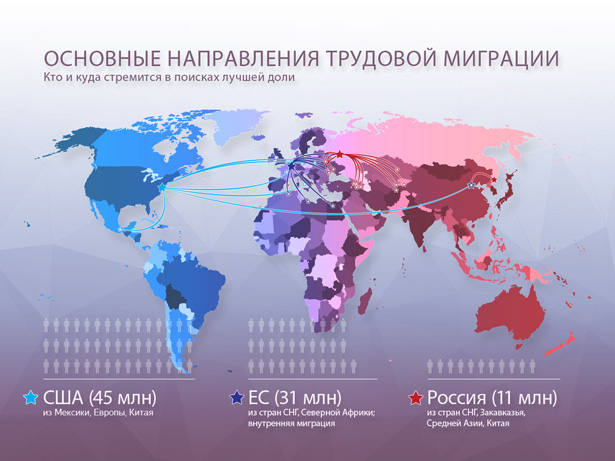Picky! Where labor migrants seek
Every December in the world is celebrated by the Day of Migrant. Labor migration has many persons and titles - from academician to black-worker, from the kitchen and to the top manager.
In each region of the planet to foreign workers their attitude. In Moscow, they hate them, and in California, the indigenous population already gives children to hispanic-speaking schools so that they are better fit into the new world. In countries with poor migration policy, migrants are a huge problem, while developed economies skillfully installed barriers leave only the best for themselves.
We tried to figure out who and where to seek in the world in search of the best share.
To Moscow
In the capital today, the most difficult situation with labor migrants in the country. It is not only here from the border, but also from all over Russia, since the difference in salaries between Moscow and the regions is completely space. As a result, the city is overcooled, and the annoyance of the inhabitants is spacked on the powerful janitors and sellers of Asian.
It all started in the 70s and 1980s. Then the term "limit" appeared: so called the provincials, "imaginary" in the growing Moscow to work. They lived in hostels and tried to stay in the capital by all their mights: they married Muscovites and married Muscovites, Tran was knocked out a new job and housing and generally behaved very unceremoniously and brazenly. They are terribly irritated by the indigenous people of Moscow - just then the winged phrases appeared "I poned here!" And "Moscow is not rubber!".
Approximately the same years include the first metropolitan experience of mass hiring of foreigners migrants. The plants of ZIL and AZLK distinguished themselves, which were delivered several hundred Vietnamese to work on the conveyor. When the USSR ordered a long time to live, some of these workers broke into the former country and illegally asslaved somewhere in the newly minted states.
With the collapse of the Union, the situation has changed dramatically. In the outskirts of the republics, wars broke out, after which countries remained in the ruins along with and not born economy. Local residents massively rushed to Moscow to earn money - and the capital flooded the faces of almost all the nationalities of the former USSR.
Today in the Moscow supermarket is almost impossible to find an employee of the hall from Moscow. In the product retail, in the markets, at construction sites, janitor, taxi drivers, there are exclusively visiting from Central Asia, the Republics of Transcaucasia, Ukraine, Belarus and Moldova. According to the FMS, the overwhelming majority of them are in the country illegally and do not have permission to work.

Ksenia Yurkova, Head of the Department "Mass selection" of the company STS Group, reports that the most common specialties of labor migrants are specialties in the field of construction, trade, catering (movers, drivers, sellers, cashiers and others). "However, each employee can achieve high results in the career, and migrants are no exception. It all depends on the level of education, professional and personal qualities of the applicant, experience, practical skills, "Yurkova adds.
In connection with the difficult economic situation, they are increasingly talking about a possible reduction in the migration flow. But while this process is located, as it is called, in the theories. Vladimir Rusanov, head of the press service of the X5 Retail Group, notes: "In X5 Retail Group, there is no sharp outflow of personnel, while they have enough employees. With the arc side, the fall of the ruble did not cause mass departures. The only, domestic currency, of course, affects labor, as we are all dependent on inflation. "
To Russia
In general, in Russia, the situation with gastarbaters varies from the region to the region. If the Caucasians for the decades of work in the country got to the most remote regions and often said there, then only the beginning of the Chinese expansion was still touched by the expanses of Siberia and the Far East. And this question for locals is now rather sharp.

In the huge territories behind the Urals, people live less than in one Moscow. The richest regions are practically not mastered - there is not enough workforce, and overpriced China has long been looking at Siberian expanses. Expansion passes quietly, but largely: Chinese business comes to remote regions - and with it thousands of workers hands.
The Chinese in the year before last decades occupied all the markets of Primorye and the neighboring regions. They work on the billet of the forest, in construction and, by itself, in trade. The indigenous population is though whether the businessmen coming from China from time to time they offer local good jobs.
There are found in the Far East and Vietnamese, and even the Northern Koreans. The latter, they say - the most hardworking and disciplined workers. Run, though, a lot.
It is noticeable from the middle temperature in the hospital, both border regions of the country are also distinguished. So, in Astrakhan and Orenburg there are many Kazakhs, in Belgorod and Rostov - Ukrainians, and Stavropol has long been occupied by Armenians.
To Europe
Migrant workers go to the old light from everywhere, including from Europe itself. Internal migration flows are not less strong now than external - this is due to the uneven economic development of the EU countries and the absence of boundaries. Mostly move into earnings in old and large countries, residents not so long ago affiliated to the European Union of Eastern States: Poland, Bulgaria, Romania, Greece, Baltic States.

From there, from the east, the supply of low-qualified workers is established - from Ukraine, Belarus, Moldova and Russia. However, it is quite difficult to obtain permission for a permanent job for non-citizens, because it is usually seasonal and watchdogs. In the north, many ride to collect berries in Finland and Sweden, in the south - building housing is all in the same Bulgaria and Greece. Women hired by housekeepers and nanny.
In turn, the Central and Western Europe has long seized immigrants from North Africa and Asia. Here the problem is much more serious: they not only come to work, but also remain to live in prosperous countries, bring families and put roots. The result is a tense social situation in France, Germany and the United Kingdom, periodically reaching mass pogroms.
At the same time, Europe attracts many highly qualified personnel from around the world. Developed European countries invite scientists, top managers, art workers and offer them long-term contracts with a prospect of obtaining a permanent residence permit. In the EU, the best brains go to the EU from Russia and continue to leave the best brains.

IN USA
The United States is the largest destination of labor migrants on the planet.
The most stressful migration corridor in the world is on the border between the United States and Mexico. Mexicans and in general, Latin Americans have long pushed the white population in the southern states: so, in California, the number of Hispanic inhabitants reaches 37%. In these regions, the expansion of migrants led to the redistribution of the language balance - the signage on the streets is duplicated in Spanish, and the passers-by can not understand you in English.
The many Asians live here, primarily the Chinese: their share in California population reaches 14%. Asians brought in the middle of the 19th century to build railways: the Chinese have concluded a contract for several years and went to work in America, where many later and downtown. In any major megalopolis of the country, including in California, there is a chinese town - the Chinese Quarter. Asian countries retain a powerful diaspora in the US, which constantly attracts new labor migrants from their homeland.
Right in the United States and Europeans, but, as a rule, with other purposes. Qualified European specialists are moved over the ocean in search of the best salary, interesting opportunities and simply within the framework of interethnic corporations. Someone goes to learn and remains in the country, someone trite comes to change the habitat and the situation. Of course, all these people leave in the United States not from great need, but something relates them to Mexicans, illegally overlooking the American border - the status of a labor migrant.

In search of the best fraction, people are ready to overcome any obstacles. Up to 80% of migrant workers in Russia work illegally, and many countries with collapsed economies live on earnings on earnings. Thus, in Tajikistan, transfers from migrant workers make up 42% of GDP, in Kyrgyzstan - 32%, in Moldova - 25%.
Labor resources are redistributed, striving for unattainable economic equilibrium. At any time, we can also be labor migrants - and who knows, is it bad, as it seems?
Who did not leave for a foreign land in search of labor happiness Alexey Maksimuk




